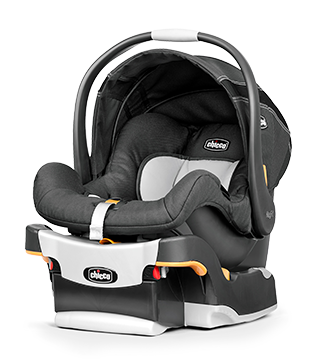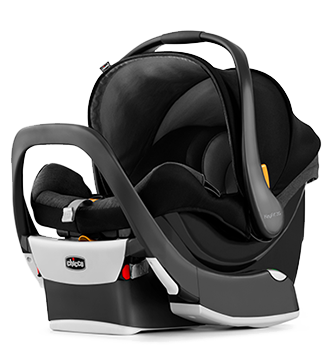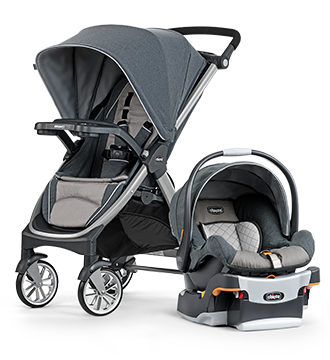What is an infant car seat?
How to Choose an Infant Car Seat
An infant car seat is rear-facing only and consists of two parts – a removable, bucket-style seat and a base that remains securely installed in your car. Designed for easy portability, this removable car seat can easily click into a stroller without disturbing your baby. Car seats for infants can support babies up to 35 lbs. or 35 inches, with some models designed for lower height and weight limits. While the definition of an infant car seat is straightforward, there are many different factors for parents to keep in mind when picking the best car seat for your baby. Chicco offers several varieties of infant car seats that you can choose from!
When should you switch from an infant car seat?
All infant car seats come with a specific height and weight limit for use. Once your baby reaches either of those milestones – typically, within 1-2 years for infant or newborn car seats – it may be time to consider purchasing a convertible car seat or 4-in-1 car seat.
Checklist for Choosing an Infant Car Seat
Infant Car Seats - Frequently Asked Questions
A baby will typically use an infant car seat for at least 9 months and - depending on the baby and the car seat - as long as 24 months. Infant car seats can be used until your baby reaches the height or weight requirements listed by the manufacturer. This information is found on the warning labels on the car seat and can also be found in the instruction manual.
The newborn insert is a specifically sized pad designed to help smaller babies properly fit the car seat. You may remove it before the baby reaches 11 lbs as long as the harness is at or below their shoulders. Only use Chicco inserts designed for the Chicco car seat you are using.
When choosing an infant car seat you may want to consider convenience features such as a no-rethread harness. A no-rethread harness can be easily adjusted as the baby grows without having to remove the 5-point harness to make adjustments. Other features to look for when choosing an infant car seat include a large canopy, infant inserts and stroller compatibility. Many infant car seats are sold as part of a travel system that includes a stroller, infant car seat and stay-in-car base.
There are multiple factors to consider when installing an infant car seat in your vehicle. The most important factor being a seat location that allows you to install your car seat correctly and works best with your family. For example, if you live in the city or park on the street you may want to consider installing the car seat on the sidewalk side to avoid getting the child in and out of the car on the street side.
All Chicco infant car seats are ready to use for a newborn out of the box. They all include a removable head and body support insert to accommodate newborns starting at 4 lbs. The harness shoulder straps should be positioned at or below the child's shoulders. Be sure to reference the instruction manual and videos for more details on how to secure your child in the car seat.
Before using the infant car seat, read the instruction manual for specific details on how to secure your child in the car seat. Some general rules include making sure the harness is at or slightly below the shoulders and the chest clip is positioned at the baby’s armpit level.
Chicco infant car seats expire 6 years after the date of manufacture. You will find the date of manufacture on an adhesive label on the bottom of the car seat. If you plan to use the car seat for multiple children make sure it has all of the original components, such as the newborn insert, and that it is functioning properly.
An infant car seat allows for the flexibility of the child to stay in the car seat while going from the house to the car or the car to a stroller. A convertible car seat can be used from birth up to 65 lbs but is much larger and does not come with a separate base as it is designed to stay in the car. In addition, an infant car seat is rear-facing only and a convertible car seat is rear-facing and then converts forward-facing for a longer duration of use. Visit our in-depth car seat comparison resource for more information.
Once your child has reached the height or weight limit of the infant car seat you will transition to either a convertible car seat or an all-in-one car seat. These types of seats will allow your child to continue to ride rear-facing until they reach between 40-50 lbs or maximize the height limits, depending on the car seat.
The KeyFit 30 infant car seat accommodates children up to 30 lbs or 30 inches while the KeyFit 35 infant car seat fits children up to 35 lbs or 32 inches. The KeyFit 35 also includes a no-rethread harness and an integrated anti-rebound bar on the base.
The infant car seat must have a label to indicate that it is certified for use on an aircraft (FAA-Approved). The American Academy of Pediatrics and the FAA recommend a child safety restraint system when flying for young children, whenever possible. The infant car seat will keep your baby secure if there is unexpected turbulence on the plane. Another option is to check your car seat as baggage. Confirm with your airline for any specific requirements they may have.
Always refer to the car seat owner’s manual prior to washing or cleaning your car seat. Many infant car seat covers and accessories can be machine washed and then allowed to air dry. Many car seat manufacturers have directions and videos on how to remove and replace the cover so be sure to use those references when possible.





